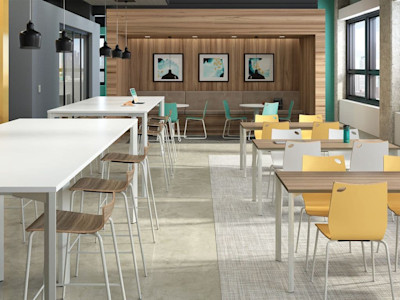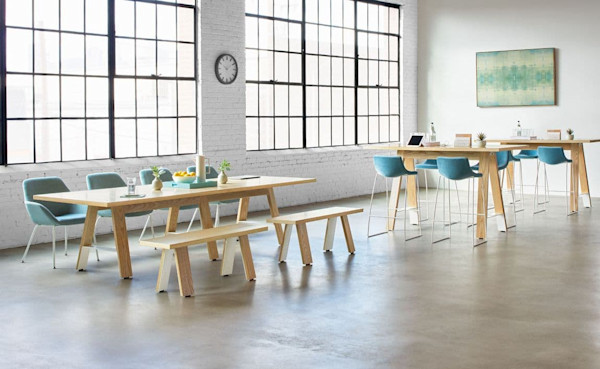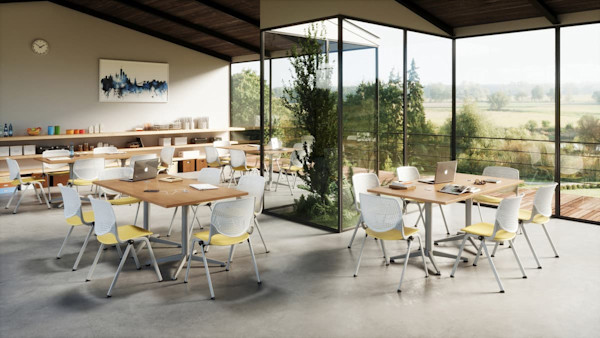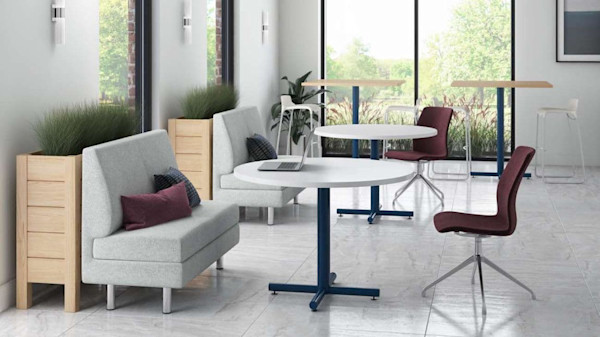Break Time in the Breakroom

When we talk about productivity, company culture, and workplace engagement, the conversation often revolves around leadership, technology, or office layout. But there’s one area that quietly plays a huge role in how employees feel about coming to work each day: the breakroom.
It’s easy to dismiss the breakroom as just a place to grab coffee or heat up lunch, but in reality, it’s one of the most important cultural hubs in your workplace. The way it’s designed and furnished sends a clear message about whether your company values connection, community, and employee well-being or just efficiency and output.
This is where what we’ll call "The Breakroom Test" comes in. Ask yourself: Does your breakroom invite people to connect? Or is it just a pit stop between meetings?
Why the Breakroom Matters More Than You Think

At first glance, the breakroom doesn’t seem like a strategic part of your office design. After all, it’s not a conference room where big decisions are made, or a workstation where the day-to-day gets done. But scratch beneath the surface and you’ll see why breakrooms are so essential:
1. They’re Culture Carriers
The breakroom is often where employees have their most unguarded conversations. It’s where people laugh about something funny that happened in a meeting, share updates about their lives, or brainstorm an idea informally. Those interactions reinforce company culture in real time. A warm, welcoming breakroom says, “We care about your comfort and relationships here.”
2. They Foster Connection
In today’s hybrid and fast-paced work environment, it’s rare to catch up with colleagues outside of structured meetings. The breakroom creates opportunities for chance encounters and organic conversations, the ones that strengthen relationships and make teams work better together.
3. They Boost Morale and Well-Being
Everyone needs a mental reset during the workday. A thoughtfully designed breakroom provides that space, helping employees feel refreshed and more engaged when they return to their tasks.
4. They Impact Retention and Recruitment
Potential hires notice these details. A breakroom that feels vibrant and inviting can be a subtle but powerful indicator of how the company values people, making a lasting impression on candidates.
The Signs of a Breakroom That Fails the Test
Before we talk about what works, let’s take a look at some telltale signs that your breakroom might be missing the mark:
Sparse, uncomfortable seating.
A couple of plastic chairs pushed against the wall won’t encourage anyone to linger or connect.
No personality.
White walls, buzzing fluorescent lights, and a neglected refrigerator send the message that this space is an afterthought.
Lack of functionality.
Not enough counter space, no room to prepare food, or outdated appliances make it more frustrating than refreshing.
Isolation by design.
If the layout forces people to sit apart, face walls, or quickly exit, it undermines the social aspect.
If this sounds familiar, you’re not alone. Many companies underinvest in their breakrooms because they see them as non-essential. But the return on creating a great breakroom is far higher than most expect.
What Makes a Breakroom Inviting?

So, what does a breakroom that passes the test look like? Let’s break it down:
1. Comfortable, Flexible Seating
People connect when they can sit comfortably. Mix it up with options: café-style tables for lunch, lounge chairs for casual chats, and counter seating for quick breaks. Modular furniture allows the space to adapt as needs shift.
2. Natural Light and Warm Lighting
If possible, position the breakroom near windows to take advantage of natural light. When that’s not an option, warm-toned lighting makes the space feel cozy and welcoming far better than harsh overhead fluorescents.
3. Thoughtful Design Details
Plants, artwork, and color go a long way in making the breakroom feel like a destination rather than a sterile stop. Even small touches, like a chalkboard wall for notes or inspirational quotes, can spark connection.
4. Functional and Appealing Amenities
Updated appliances, plenty of counter space, good coffee, filtered water, and healthy snack options show employees that their needs are valued. These practical details set the tone for how people experience the space.
5. Room to Gather
Make sure the space is large enough to accommodate groups without feeling cramped. This encourages teams to use the breakroom for informal meetings or celebrations.
6. Inclusivity by Design
A great breakroom makes everyone feel welcome. Consider accessibility, dietary diversity, and cultural inclusivity in your layout, amenities, and offerings.
The Psychology Behind the Breakroom
Why does furniture and design make such a difference in how people connect? It comes down to psychology. Human beings are deeply influenced by their physical surroundings, and office furniture plays a big role in shaping behavior.
Proximity encourages conversation.
Tables and seating designed for groups make it easy to chat, while isolated seating discourages interaction.
Comfort lowers barriers.
When employees feel physically comfortable, they’re more likely to relax and engage socially.
Visual cues guide behavior.
A vibrant, well-designed space signals that people are invited to stay and connect. A cold, empty room signals the opposite.
When you design a breakroom intentionally, you’re essentially nudging employees toward positive interactions that strengthen culture.
The Breakroom as a Collaboration Hub
Some of the best ideas in companies come from casual conversations. The breakroom can act as a mini innovation hub when it’s designed for connection.
Imagine this: two employees from different departments bump into each other while grabbing coffee. One mentions a problem they’re trying to solve. The other shares a perspective they wouldn’t have heard otherwise. That spontaneous exchange might lead to a new solution or idea.
This “collision” of ideas happens most often in shared, comfortable spaces like a well-designed breakroom.
How to Upgrade Your Breakroom

If you’re realizing your current breakroom might not be sending the right signals, the good news is that upgrades don’t have to be massive to make a difference. Here are some steps to consider:
Start with the Furniture
Invest in furniture that’s both functional and inviting. At StrongProject, we specialize in modern office furniture designed to encourage connection, collaboration, and comfort. Whether it’s sleek café tables, ergonomic lounge chairs, or modular seating that adapts to your team’s needs, the right furniture lays the foundation for an inviting space.
Add Visual Warmth
Incorporate color through furniture, wall accents, or décor. Even subtle changes can shift the atmosphere from sterile to welcoming.
Upgrade the Essentials
Don’t underestimate the impact of a good coffee machine, reliable appliances, and clean, functional surfaces. These basics are the backbone of the employee breakroom experience.
Create Zones
Designate areas for different types of interactions: a counter for quick solo breaks, tables for small groups, and lounge areas for relaxed conversations. This ensures the space works for everyone.
Ask Employees What They Want
One of the simplest ways to pass the breakroom test? Ask the people who use it. Employees often have great ideas for what would make the space more functional and inviting.
Passing the Breakroom Test
At the end of the day, the breakroom is a reflection of how much your company values people. When employees see that their comfort and connection matter, they feel more engaged, more loyal, and more willing to bring their best selves to work.
So ask yourself: if a candidate, client, or employee walked into your breakroom today, what story would it tell about your company? Would it show that you’re committed to connection, culture, and well-being? Or would it reveal that those values are more talk than action?
Passing the breakroom test doesn’t require an enormous budget or a complete redesign. It requires intentionality. And with the right approach and the right furniture, you can transform your breakroom into one of the most powerful tools for connection in your workplace.
It's Break Time in the Breakroom
Workplaces are more than just desks and computers; they’re ecosystems of people, relationships, and shared experiences. The breakroom, humble as it may seem, is at the heart of that ecosystem. By treating it as a central part of your office design strategy, you give employees a reason to feel connected, energized, and valued every single day.
At StrongProject, we believe that the furniture you choose for your office should do more than fill space; it should inspire connection, collaboration, and culture. If your breakroom isn’t inviting people to connect, it may be time to rethink the design.



